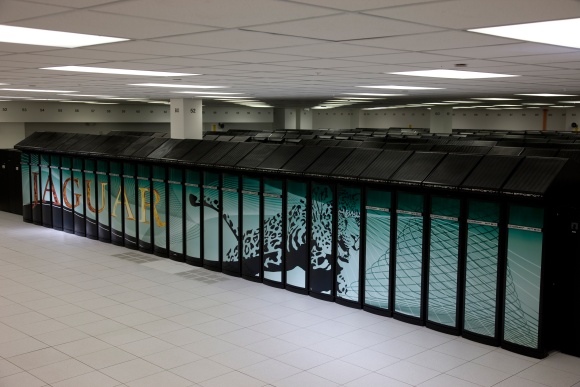
Twice a year, the world’s top 500 supercomputers are announced. The most recent winner is the Jaguar which pretty much wiped the floor with the competition, managing a performance benchmark 69% above the IBM Roadrunner which came in second.
Let’s take a closer look at the Jaguar, the fastest supercomputer in the world today.
Quick data about the Jaguar
- Performance: 1.759 petaflops (theoretical maximum: 2.33 petaflops)
- Processors: 37,376 six-core AMD Opteron 2.6 GHz
- Processor cores: 224,256
- Total RAM: 300 terabyte
- Total disc space: 10 petabyte
- System type: Cray XT5
- Operating system: Cray custom version of SUSE Linux
One petaflops is the equivalent of one thousand trillion operations per second, which means the Jaguar is capable of a theoretical maximum performance of 2,330,000,000,000,000 operations per second.
The computing power of the Jaguar is used by scientists to run simulations of climate changes and effects, supernovas, and a number of other compute-intensive applications.
The Jaguar Cray XT5 setup takes up 4,400 square feet (409 square meters), which is larger than an NBA basketball court.
Pictures





Images courtesy of the National Center for Computational Sciences, Oak Ridge National Laboratory.
A look inside
The Jaguar has been around for a while but never quite reached the top spot. The reason Jaguar claimed the top spot in this latest test is a recent upgrade from quad-core processors to six-core processors, effectively increasing the total number of processor cores by 50%.
For those who are curious what the inside of the compute units of the Jaguar looks like, here is a video of a Cray engineer demonstrating the process of upgrading the units.
This video is from the upgrade of Kraken, not the Jaguar, but it’s the same type of Cray XT5 system. The Kraken is the world’s third fastest supercomputer and is located at the same facility as the Jaguar, the National Center for Computational Sciences.
Do you like supercomputers? Then you might also want to have a look at these:
Data sources: National Center for Computational Sciences and Top500.org.



























